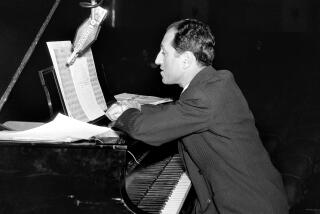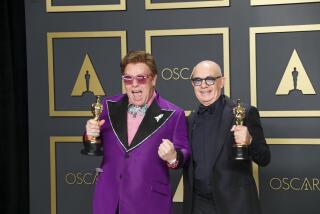A key change for Gershwin archive
Reporting from San Francisco ââŹâ â Sharing the street level with a Subway sandwich shop in San Franciscoâs South of Market district, the tiny lobby of a three-story brick building offers few clues that a treasure trove of music, theater and film is inside.
From a sidewalk bustling with hipsters and high-tech workers, a sharp-eyed passerby might spot a movie poster of Gene Kelly and Leslie Caron dancing in âAn American in Paris.â But otherwise, there is little to indicate that, behind the doors, lies an immense archive of one of the most beloved and influential songwriting teams in American history: composer George Gershwin and his lyricist brother, Ira.
FOR THE RECORD:
Gershwin archive: A front page index item in the Oct. 30 Section A referring to an article in that dayâs Calendar section about a Gershwin archive relocating from San Francisco to Washington, D.C., said that the archive was moving to the Smithsonian. The collection, which includes photos, recordings, musical scores, programs and letters from composer George Gershwin and his lyricist brother Ira, is moving to the Library of Congress, as the article said. â
Inside, carefully preserved, are more than 15,000 photos, recordings, musical scores, programs and letters from the men whose Broadway and Hollywood work from the 1920s and â30s lives on in such favorites as âThey Canât Take That Away From Me,â âThe Man I Loveâ and â âS Wonderful.â The basement storeroom holds memorabilia from their opera âPorgy and Bess,â as well as from Georgeâs classical compositions, which remain concert hall standards.
âIt has an amazing amount of stuff,â said Richard Crawford, a University of Michigan emeritus professor of musicology who is using the archive to research a biography of George Gershwin. After significant time there, he remains in awe of the brothersâ partnership.
âThere is something about that synergy between the words and the music,â Crawford said. âItâs simple and itâs profound. Itâs almost like human creativity at its best.â
Among the archiveâs many items are the program for the 1924 premiere of George Gershwinâs jazzy âRhapsody in Blue,â complete with doodles by Ira; a stage managerâs script from âGirl Crazy,â the 1930 musical that introduced âI Got Rhythmâ and âEmbraceable Youâ; and a 1923 letter to George from performer Adele Astaire, Fredâs sister, saying that Britainâs Prince of Wales had hummed Georgeâs tunes and told her he was âfrightfully interestedâ in the composer.
Now, however, big change is afoot.
After decades in Beverly Hills and then San Francisco, the collection, from the estate of Ira and his wife, Leonore, will be moved next year to Washington, D.C. There, it will join another large archive of Gershwin memorabilia, music and documents at the Library of Congress, to which it has long been pledged.
The San Francisco archive will close by yearâs end, according to Michael Strunsky, Leonoreâs nephew, who heads the trusts she established. Ten years ago, Strunsky, a construction industry executive, moved the collection to San Francisco, where he lives. He has supported it with royalties and licensing from Iraâs portion of the brothersâ partnership and from Iraâs work with such composers as Kurt Weill and Harold Arlen.
But Strunsky said visits by researchers to the archive have dipped in recent years, as have productions of Gershwin shows and royalties. He declined to discuss financial details.
âThe telephone doesnât ring as often as it used to. We are just further away from the creation of the work,â he said, in a room decorated with posters of Gershwin shows and movies. One advertised the 1937 Hollywood Bowl concert starring Bing Crosby and Fred Astaire that honored George two months after he died of a brain tumor at age 38.
Of the archive move, Strunsky, who is 76, said: âItâs time, and the fact that Iâm getting a little older.â
The chance to work on movie musicals had brought the Gershwin brothers from New York to California for a brief stint in 1930. Then, starting in August 1936, they shared a rented house on North Roxbury Drive in Beverly Hills while composing for Fred Astaire films.
Ira and Leonore Gershwin stayed there after Georgeâs death in Los Angeles the following summer and then bought the house next door, where they remained the rest of their lives. Ira died in 1983 and, before she died eight years later, Leonore said she wanted the extensive collection in their home to go eventually to the national library. (George, two years younger than Ira, never married and neither brother had children; work by George is controlled by another family branch.)
But Leonoreâs will allowed the items to stay in California for as long as Strunsky wanted.
At the Library of Congress, donor relations officer Betty Auman said she was âsurprised and delightedâ by Strunskyâs decision to move the archive next year. The libraryâs music division had not expected it for two decades, when many Gershwin copyrights start to expire, she said.
In Washington, the memorabilia will join an extensive Gershwin collection that includes more original scores and manuscripts, as well as Georgeâs piano. Some Library of Congress items were purchased; many were donated by Ira and Gershwin relatives and friends.
Singer Michael Feinstein, a prominent Gershwin interpreter, praised Strunsky and the trusts for an important stewardship. âThe chronicle of the lives of both the Gershwins is not only the cliched American Dream,â he said of the sons of Russian-Jewish immigrants. âIt is a snapshot of musical life in America that still has resonance and relevance to people today.â
Feinstein, who was a personal assistant to Ira Gershwin in the late 1970s and helped organize his scrapbooks and recordings, said he has mixed feelings about the collectionâs move.
âIt will be lovingly tended, and there is no question it will be in the best of hands,â he said. âBut personally Iâm sad to see it move from part of the family to be overseen instead by a government.â
At the Library of Congress, the collection will be governed by stricter rules, and that may mean longer waits to obtain copies of orchestrations and other materials, said Feinstein, who is developing a museum in Indiana dedicated to âthe Great American Songbook.â
For his part, Crawford said he worries that the move will make rare material less accessible. The professor also said he will miss the personal touch of current San Francisco archivist Michael Owen and Owenâs predecessor, Mark Trent Goldberg, who died in 2005.
However, Susan Vita, music division chief at the Library of Congress, said such concerns are unfounded. âThis is one of the easiest and most accommodating places to use material,â she said.
Maintaining the Gershwin heritage is important to the library, Vita said. The national library has named its prize for popular song after the Gershwins; the third annual award was presented this year to Paul McCartney at a White House ceremony.
(In another link to the rock music era, former Beach Boy Brian Wilson recently released an album of Gershwin music, including two songs that he and a collaborator finished from Gershwin fragments.)
In San Francisco, archivist Owen cites the brothersâ song titles and Broadway opening dates with ease. But in just a few months, he will, with a pang, start dismantling the basement archives room where a blowup of a 1950s photo of Ira and Leonore presides.
Among Owenâs favorite items, there is a letter in which George tells an East Coast friend about his still grudging, but growing, appreciation for California. It dates from 1936, when the Gershwins were in Hollywood, composing such classics as âThey All Laughedâ and âLetâs Call the Whole Thing Off.â
âI hate to admit it, but all of the annoying talk that Californians generally give us Easterners about their climate, I am afraid is true,â he writes. âIn other words, itâs a damn fine place in which to live.â
More to Read
The biggest entertainment stories
Get our big stories about Hollywood, film, television, music, arts, culture and more right in your inbox as soon as they publish.
You may occasionally receive promotional content from the Los Angeles Times.











